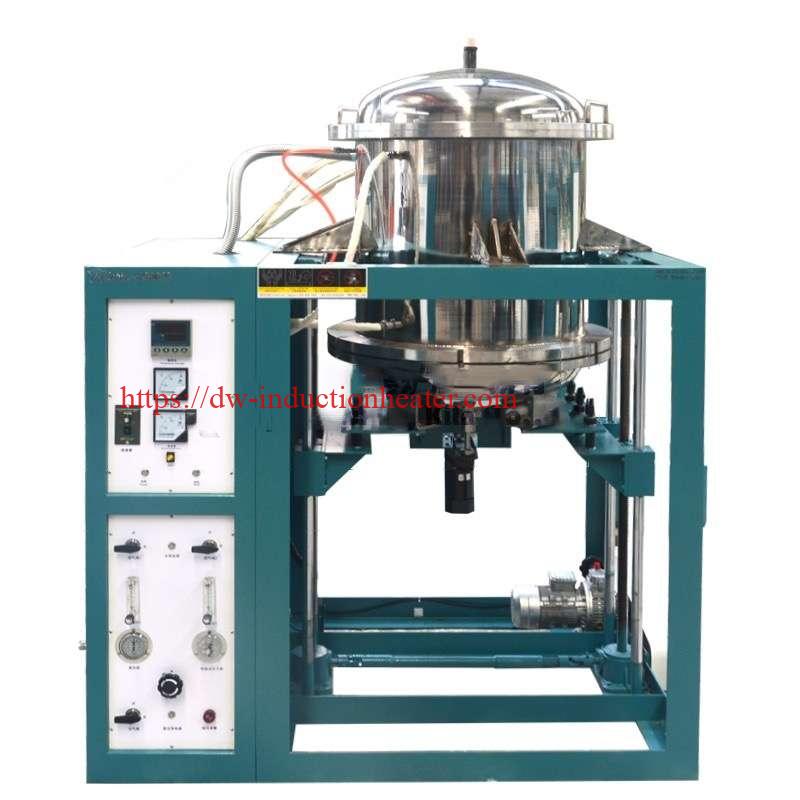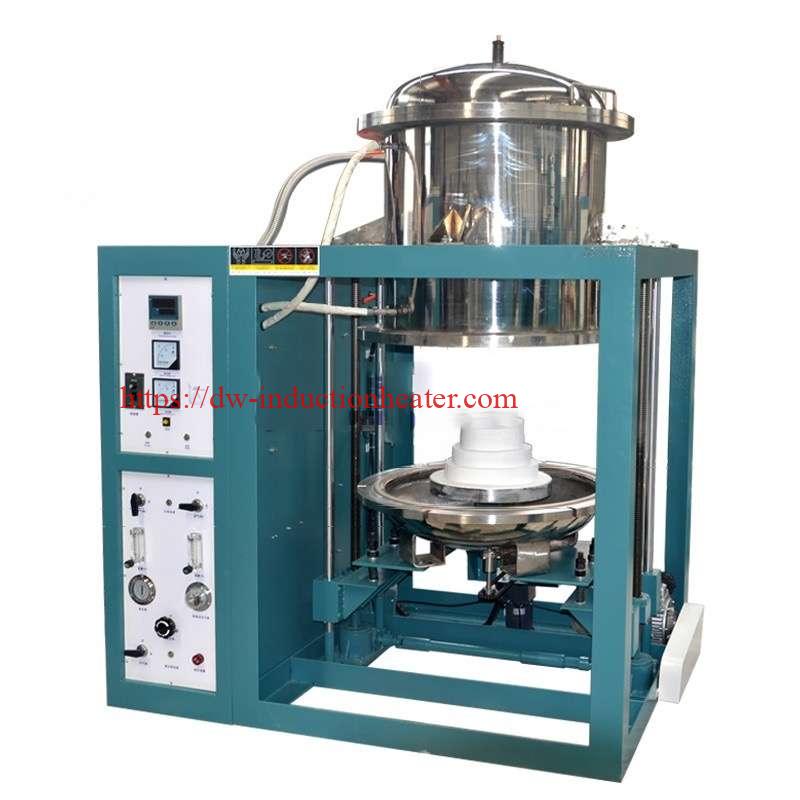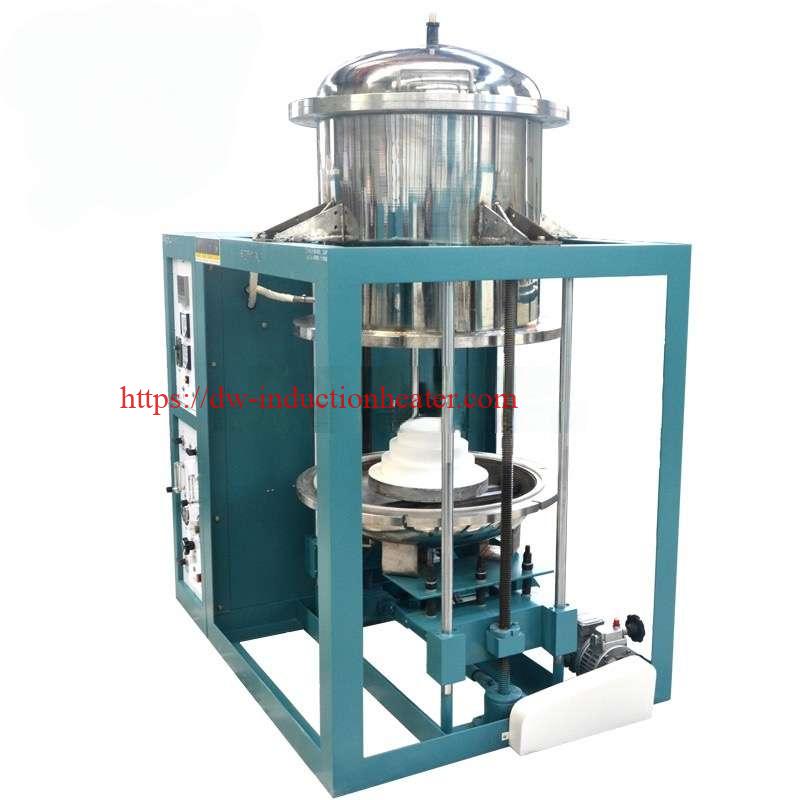 A 1200°C-1700°C lifting vacuum atmosphere furnace
A 1200°C-1700°C lifting vacuum atmosphere furnace is a specific type of furnace designed to operate within a temperature range of 1200 to 1700 degrees Celsius under vacuum conditions or in a controlled atmosphere environment. The term "lifting" suggests that this furnace likely has a feature that allows the workload to be raised and lowered within the chamber for loading and unloading purposes.

The development of high-temperature lifting
vacuum atmosphere furnaces has revolutionized various industrial and research applications that require precise temperature control, contamination-free environments, and specialized atmospheres. Operating at temperatures ranging from 1200°C to 1700°C, these advanced systems offer unparalleled capabilities for materials processing, treatment, and synthesis. This article delves into the technological innovations, design considerations, and multifaceted applications of these powerful thermal processing tools.
Introduction:
The engineering of materials under controlled conditions is fundamental to the advancement of modern technology. High-temperature lifting vacuum atmosphere furnaces have emerged as critical equipment for such endeavors, catering to the needs of industries like aerospace, automotive, ceramics, metallurgy, and electronics. These furnaces are designed to provide a vacuum or inert atmosphere that prevents contamination and oxidation during high-temperature processes. The lifting mechanism is a key feature that allows for ergonomic loading and unloading of materials, as well as effective integration into production lines.
Technological Innovations:
The technological advancements in lifting
vacuum atmosphere furnaces are manifold. Innovations such as advanced refractory materials for insulation, precision temperature control systems, and robust sealing mechanisms ensure performance stability and reliability at extreme temperatures. The integration of modern control systems, including programmable logic controllers (PLC) and human-machine interfaces (HMI), enable precise regulation of temperature profiles, atmosphere composition, and pressure levels.
Design Considerations:
The design of lifting vacuum atmosphere furnaces must address several critical factors to ensure operational efficiency and safety. Thermal uniformity is achieved through carefully engineered heating elements and furnace geometry. Load considerations, such as size, weight, and thermal properties, dictate the structural aspects of the lifting mechanism. Additionally, safety features like over-temperature protection and emergency shutdown capabilities are incorporated to protect both the operators and the processed materials.
 Materials Processing and Treatment:
Materials Processing and Treatment:
High-temperature vacuum atmosphere furnaces facilitate a range of materials processing and treatment techniques. These include sintering of advanced ceramics and composites, annealing of metallic alloys, and synthesis of high-purity materials. The controlled atmosphere allows for the reduction of oxides, nitrides, and other compounds, which is essential for producing materials with specific microstructures and properties.
Applications in Research and Industry:
The versatility of lifting vacuum atmosphere furnaces is evident in their widespread applications across various sectors. In the field of materials science research, these furnaces are instrumental in synthesizing novel materials and studying phase transformations. In industry, they are used for heat treatment processes that enhance the mechanical properties of components, such as
annealing,hardening, tempering, and brazing. The electronics industry benefits from the ability to create semiconductor materials and components under ultra-clean and controlled conditions.
 Challenges and Future Prospects:
Challenges and Future Prospects:
Despite their advantages, high-temperature lifting vacuum atmosphere furnaces face challenges related to energy consumption, maintenance, and the handling of volatiles at elevated temperatures. Future developments are expected to focus on improving energy efficiency, extending service life, and incorporating advanced sensing technologies for real-time monitoring and process optimization.
Conclusion:
High-temperature
lifting vacuum atmosphere furnaces are indispensable tools in the realms of advanced materials development and industrial processing. Their ability to operate at 1200°C to 1700°C under controlled atmospheres makes them a cornerstone of innovation in high-temperature material science and engineering. As technology progresses, these
electric furnaces will continue to evolve, further enhancing their capabilities and expanding their applications in various cutting-edge fields.
[pdf-embedder url="https://dw-inductionheater.com/wp-content/uploads/2024/03/Vacuum-Atmosphere-Furnace-En.pdf" title="Vacuum Atmosphere Furnace En"]
https://dw-inductionheater.com/product/1200c-1700c-lifting-vacuum-atmosphere-furnace-lifting-bottom-vacuum-heat-treatment-furnace?feed_id=236323&_unique_id=65f069e2873f0
 A 1200°C-1700°C lifting vacuum atmosphere furnace is a specific type of furnace designed to operate within a temperature range of 1200 to 1700 degrees Celsius under vacuum conditions or in a controlled atmosphere environment. The term "lifting" suggests that this furnace likely has a feature that allows the workload to be raised and lowered within the chamber for loading and unloading purposes.
A 1200°C-1700°C lifting vacuum atmosphere furnace is a specific type of furnace designed to operate within a temperature range of 1200 to 1700 degrees Celsius under vacuum conditions or in a controlled atmosphere environment. The term "lifting" suggests that this furnace likely has a feature that allows the workload to be raised and lowered within the chamber for loading and unloading purposes. The development of high-temperature lifting vacuum atmosphere furnaces has revolutionized various industrial and research applications that require precise temperature control, contamination-free environments, and specialized atmospheres. Operating at temperatures ranging from 1200°C to 1700°C, these advanced systems offer unparalleled capabilities for materials processing, treatment, and synthesis. This article delves into the technological innovations, design considerations, and multifaceted applications of these powerful thermal processing tools.
Introduction:
The engineering of materials under controlled conditions is fundamental to the advancement of modern technology. High-temperature lifting vacuum atmosphere furnaces have emerged as critical equipment for such endeavors, catering to the needs of industries like aerospace, automotive, ceramics, metallurgy, and electronics. These furnaces are designed to provide a vacuum or inert atmosphere that prevents contamination and oxidation during high-temperature processes. The lifting mechanism is a key feature that allows for ergonomic loading and unloading of materials, as well as effective integration into production lines.
Technological Innovations:
The technological advancements in lifting vacuum atmosphere furnaces are manifold. Innovations such as advanced refractory materials for insulation, precision temperature control systems, and robust sealing mechanisms ensure performance stability and reliability at extreme temperatures. The integration of modern control systems, including programmable logic controllers (PLC) and human-machine interfaces (HMI), enable precise regulation of temperature profiles, atmosphere composition, and pressure levels.
Design Considerations:
The design of lifting vacuum atmosphere furnaces must address several critical factors to ensure operational efficiency and safety. Thermal uniformity is achieved through carefully engineered heating elements and furnace geometry. Load considerations, such as size, weight, and thermal properties, dictate the structural aspects of the lifting mechanism. Additionally, safety features like over-temperature protection and emergency shutdown capabilities are incorporated to protect both the operators and the processed materials.
The development of high-temperature lifting vacuum atmosphere furnaces has revolutionized various industrial and research applications that require precise temperature control, contamination-free environments, and specialized atmospheres. Operating at temperatures ranging from 1200°C to 1700°C, these advanced systems offer unparalleled capabilities for materials processing, treatment, and synthesis. This article delves into the technological innovations, design considerations, and multifaceted applications of these powerful thermal processing tools.
Introduction:
The engineering of materials under controlled conditions is fundamental to the advancement of modern technology. High-temperature lifting vacuum atmosphere furnaces have emerged as critical equipment for such endeavors, catering to the needs of industries like aerospace, automotive, ceramics, metallurgy, and electronics. These furnaces are designed to provide a vacuum or inert atmosphere that prevents contamination and oxidation during high-temperature processes. The lifting mechanism is a key feature that allows for ergonomic loading and unloading of materials, as well as effective integration into production lines.
Technological Innovations:
The technological advancements in lifting vacuum atmosphere furnaces are manifold. Innovations such as advanced refractory materials for insulation, precision temperature control systems, and robust sealing mechanisms ensure performance stability and reliability at extreme temperatures. The integration of modern control systems, including programmable logic controllers (PLC) and human-machine interfaces (HMI), enable precise regulation of temperature profiles, atmosphere composition, and pressure levels.
Design Considerations:
The design of lifting vacuum atmosphere furnaces must address several critical factors to ensure operational efficiency and safety. Thermal uniformity is achieved through carefully engineered heating elements and furnace geometry. Load considerations, such as size, weight, and thermal properties, dictate the structural aspects of the lifting mechanism. Additionally, safety features like over-temperature protection and emergency shutdown capabilities are incorporated to protect both the operators and the processed materials. Materials Processing and Treatment:
High-temperature vacuum atmosphere furnaces facilitate a range of materials processing and treatment techniques. These include sintering of advanced ceramics and composites, annealing of metallic alloys, and synthesis of high-purity materials. The controlled atmosphere allows for the reduction of oxides, nitrides, and other compounds, which is essential for producing materials with specific microstructures and properties.
Applications in Research and Industry:
The versatility of lifting vacuum atmosphere furnaces is evident in their widespread applications across various sectors. In the field of materials science research, these furnaces are instrumental in synthesizing novel materials and studying phase transformations. In industry, they are used for heat treatment processes that enhance the mechanical properties of components, such as annealing,hardening, tempering, and brazing. The electronics industry benefits from the ability to create semiconductor materials and components under ultra-clean and controlled conditions.
Materials Processing and Treatment:
High-temperature vacuum atmosphere furnaces facilitate a range of materials processing and treatment techniques. These include sintering of advanced ceramics and composites, annealing of metallic alloys, and synthesis of high-purity materials. The controlled atmosphere allows for the reduction of oxides, nitrides, and other compounds, which is essential for producing materials with specific microstructures and properties.
Applications in Research and Industry:
The versatility of lifting vacuum atmosphere furnaces is evident in their widespread applications across various sectors. In the field of materials science research, these furnaces are instrumental in synthesizing novel materials and studying phase transformations. In industry, they are used for heat treatment processes that enhance the mechanical properties of components, such as annealing,hardening, tempering, and brazing. The electronics industry benefits from the ability to create semiconductor materials and components under ultra-clean and controlled conditions. Challenges and Future Prospects:
Despite their advantages, high-temperature lifting vacuum atmosphere furnaces face challenges related to energy consumption, maintenance, and the handling of volatiles at elevated temperatures. Future developments are expected to focus on improving energy efficiency, extending service life, and incorporating advanced sensing technologies for real-time monitoring and process optimization.
Conclusion:
High-temperature lifting vacuum atmosphere furnaces are indispensable tools in the realms of advanced materials development and industrial processing. Their ability to operate at 1200°C to 1700°C under controlled atmospheres makes them a cornerstone of innovation in high-temperature material science and engineering. As technology progresses, these electric furnaces will continue to evolve, further enhancing their capabilities and expanding their applications in various cutting-edge fields.
[pdf-embedder url="https://dw-inductionheater.com/wp-content/uploads/2024/03/Vacuum-Atmosphere-Furnace-En.pdf" title="Vacuum Atmosphere Furnace En"]
https://dw-inductionheater.com/product/1200c-1700c-lifting-vacuum-atmosphere-furnace-lifting-bottom-vacuum-heat-treatment-furnace?feed_id=236323&_unique_id=65f069e2873f0
Challenges and Future Prospects:
Despite their advantages, high-temperature lifting vacuum atmosphere furnaces face challenges related to energy consumption, maintenance, and the handling of volatiles at elevated temperatures. Future developments are expected to focus on improving energy efficiency, extending service life, and incorporating advanced sensing technologies for real-time monitoring and process optimization.
Conclusion:
High-temperature lifting vacuum atmosphere furnaces are indispensable tools in the realms of advanced materials development and industrial processing. Their ability to operate at 1200°C to 1700°C under controlled atmospheres makes them a cornerstone of innovation in high-temperature material science and engineering. As technology progresses, these electric furnaces will continue to evolve, further enhancing their capabilities and expanding their applications in various cutting-edge fields.
[pdf-embedder url="https://dw-inductionheater.com/wp-content/uploads/2024/03/Vacuum-Atmosphere-Furnace-En.pdf" title="Vacuum Atmosphere Furnace En"]
https://dw-inductionheater.com/product/1200c-1700c-lifting-vacuum-atmosphere-furnace-lifting-bottom-vacuum-heat-treatment-furnace?feed_id=236323&_unique_id=65f069e2873f0
